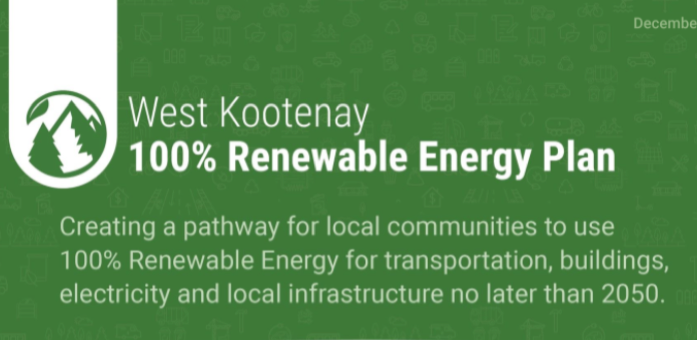Commitment made to renewable energy plan for the city
The city is all in when it comes to a regional renewable energy plan.
A West Kootenay EcoSociety renewable energy plan for the city — and for the region as a whole — was officially endorsed by city council recently, putting the community on the roadmap toward achieving a shared 100 per cent renewable energy goal by 2050.
Nine West Kootenay local governments have adopted the 100 per cent renewable energy target, including Nelson, and took part in the exercise to develop the renewable energy roadmap over the last two years.
The exercise was undertaken to address the region’s shared needs related to reducing emissions in order to navigate to a renewable energy transition.
Two years ago council voted in favour of committing to derive 100 per cent of its net energy from renewable resources by 2050, with a memorandum of understanding signed with the EcoSociety and the other participating local governments to participate in the West Kootenay 100 per cent Renewable Energy Working Group.
As of March 2 the councils of four municipalities have formally approved the plan: Castlegar, Kaslo, Warfield, and Rossland.
The roadmap
In order to align with targets congruent with the Intergovernmental Panel on Climate Change 1.5°C report, Nelson must reduce its greenhouse gas (GHG) emissions from 75,000 tonnes CO2e — 2030 business as usual projection — to 36,000 tonnes CO2e, the 2030 target.
“This equates to a total of 39,000 tonnes CO2e emissions reductions,” read a city staff report from planner Alex Thumm.
Looking ahead to 2050, GHG emissions must be reduced from 55,000 tonnes to zero.
Thumm said implementing the Nelson Climate Change Action Plan will achieve the City of Nelson’s 100 per cent renewable by 2050 target.
“Like any long-term plan, the City of Nelson will need to measure its progress and adapt its actions to changing conditions,” he wrote in his report. “As the City of Nelson moves to implement the Nelson Climate Change Action Plan in 2021, the City of Nelson will remain a partner in the West Kootenay 100 per cent Renewable Energy collaboration.”
Accordingly, the collaboration is expected to offer opportunities to “continue strengthening regional relationships, pursue opportunities for funding, learning, and capacity building, and share resources and knowledge.”
Source: City of Nelson
Nelson’s actions and ambition levels
Nelson’s actions are included in the forthcoming Nelson Climate Change Action Plan, which will be released for public review after it is completed.
“Nevertheless, due to Nelson’s multiple commitments to climate change action, the projected emissions reductions were based on ‘full’ ambition for each move, except for commercial vehicles, where no ‘full’ ambition moves exist at this time,” Thumm explained in his report.
According to information from the Federation of Canadian Municipalities, 50 per cent of Canada’s greenhouse gas emissions are within the direct or indirect control of municipal governments.
In fact, cities are leading the renewable energy transition in Canada and around the world, with Vancouver, Saanich, Oxford County, Victoria and four communities in the Slocan Valley having pledged to get to 100 per cent renewable by 2050 in community emissions sectors of transportation, electricity and buildings.
The renewable plan
The plan involves moving to 100 per cent renewable energy at the community level — heating and cooling, transportation and electricity — with a target of 34 per cent less energy demand by 2050.
Toward that end, transportation is the key area where the scenario would see the greatest reduction, from 1.220 terawatt hours (TWh) to 0.305 TWh.
A terawatt hour is used for metering larger amounts of electrical energy to industrial customers and in power generation. The terawatt hour and petawatt hour (PWh) units are large enough to express the annual electricity generation for whole communities or even countries.
In terms of the model proposed, electricity usage would increase slightly from 0.758 TWh to 0.809 TWh, while heating would remain the same at .561 TWh (and would include renewable natural gas, biomass and electricity as its sources).
The energy demand overall is targeted to go from 2.539 TWh to 1.675 TWh, with the projected energy mix comprising 43.7 per cent hydroelectric, 27.2 photovoltaic, 11.8 per cent biomass electricity, 10.6 per cent biomass heat and 6.7 per cent renewable natural gas.
The top four strategies by impact will be:
- electrifying passenger vehicles;
- better existing buildings;
- shift beyond the car; and
- organics and landfill gas capture.
Nelson-specific inventory and model
The following assumptions were made, specific to the inventory and action modelling for the city of Nelson.
- 31 per cent of homes have secondary wood heating, 1.7 per cent have propane heating, and 0.3 per cent have heating oil as per drive-by heating survey results;
- one per cent annual reduction in emissions through residential organics diversion to 2030;
- 10-year lag before landfill gas capture system is installed, accounting for time required to coordinate with RDCK, develop business cases, and acquire funding. Ramp up emission reduction to 80 per cent by 2050; and
- assumes a district energy system capable of delivering 9,600 GJ of biomass energy and 3,200 GJ of electricity will be generated by 2040 to displace fossil fuel heating.
Source: West Kootenay 100 per cent Renewable Energy Plan


























